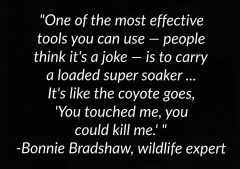Neighborhood social media pages have abounded with coyote sightings the last few weeks, and 911 Wildlife expert Bonnie Bradshaw says she knows why.
Coyotes are in every major city in the United States, Bradshaw says, and every year around this same time wildlife hotlines receive tons of calls about coyote sightings in urban areas. Why? Well, she’s thrilled y’all asked.
Coyotes are nocturnal during the summer, so people don’t see them then, she says. But during the winter coyotes come out in the daytime to hunt and to meet up with their old lovers.
“Coyotes mate for life,” Bradshaw says. “The male and the female work very hard together during the spring and summer to raise their pups, and in the fall they take a break from each other. We could learn a lot from coyotes. In January they start calling for each other. What holiday comes in the middle of February? That’s right, coyotes celebrate Valentine’s Day. Then they have pups in April.”
At this point in the meeting neighbors start speaking up, insisting that there has been more activity this year than in the past, which could be true and there’s a reason for that too, Bradshaw says.
“What’s happening is that the coyotes that have been living here for years are even more comfortable here because nobody challenges them,” Bradshaw explains. “When people see a coyote in an urban environment lying in someone’s front yard in the middle of the day, they typically do one of two things: they run away or they pull out their phone and take pictures. That teaches the coyotes that they’re king.”
Luckily, that can be reversed because coyotes naturally have a fear of people, she says. Neighbors simply need to trigger that fear.
“All it takes is stepping towards the coyote, shouting and clapping your hands,” she says. “Pick up a rock or a stick and aim to hit. One of the most effective tools you can use — people think it’s a joke — is to carry a loaded super soaker because those things will shoot thirty feet, and if you make physical contact it changes their behavior. It’s like the coyote goes, ‘You touched me, you could kill me.’ ”
 Unlike stray dogs, coyotes don’t become aggressive when humans startle them, Bradshaw says. Instead they run.
Unlike stray dogs, coyotes don’t become aggressive when humans startle them, Bradshaw says. Instead they run.
“Please, feel comfortable acting aggressively towards coyotes when you see them,” she stresses.
People once believed urban coyotes were living on cats and garbage, but Bradshaw says research shows that’s not true. It’s true that occasionally coyotes will eat cats and small dogs, but the bulk of an urban coyote’s diet is actually rodents, like mice and squirrels.
“Coyotes are extremely intelligent creatures, and they’d rather not go after food that fights back,” she points out.
Usually people want to trap and relocate the coyotes, but Dallas tried that years ago and it didn’t work because it isn’t an effective method, Bradshaw says. All it does is create a vacancy that’s quickly filled by other coyotes because where there is food there will be coyotes.
So then what can neighbors do? Three things: eliminate concentrated food sources, eliminate den sites, and give ’em hell (as described above).
Bird feeders are a magnet for coyotes; not because of the bird feed, but because of the small critters it attracts — birds, squirrels, mice, etc. Bradshaw says neighbors with bird feeders should only put out a small amount of food in the morning so the feeder isn’t overflowing and attracting unwanted guests. Neighbors also shouldn’t leave cat food outside at night. “Coyotes can smell that from a long way away,” she says. “They have that canine sense of smell.” Don’t leave unsecured garbage bags out at night. And finally, lock your pet doors at night. Dogs and cats under 10 pounds shouldn’t be outside unsupervised, she says.
To help eliminate den sites, cover foundation vents and openings in your attic with wire mesh. (If you know of a den site, call 911 Wildlife for advice.)
Her information is based primarily on urban coyote research out of Chicago.
“We’re very fortunate that 12 years ago Cook County in Illinois got funding to study urban coyotes,” she says, referring to this study. “They started 12 years ago putting radio collars on coyotes in Chicago, and now they have 900 coyotes wearing radio collars in metropolitan Chicago, and that gives us a tremendous amount of information about what coyotes are doing in cities.”
If you have questions or want someone from 911 Wildlife to come speak in your neighborhood, call 214.368.5911 to set up a meeting. Go to the website for more.






